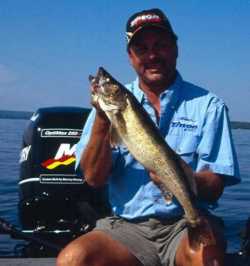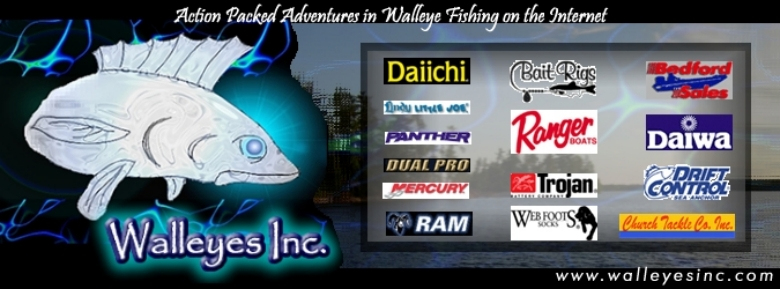|
No more crowded classroom nooks … No more rules
from nature's books … No more anglers' hungry looks … No more
food with barbs and hooks! Walleye school is out for the springtime.
The bell has rung, the doors are open, and all those fish
compelled to stack up in traditional April locations are wiggling
their fins and striking out on their own for a summer of adventure.
It's a time of year when walleyes are likely to do just about
anything and a time when they seldom stay in one place for
long. It's a time when they feed voraciously and a time when
they will eat just about anything. Consequently, it's a great
time of year for anglers who hold this species in high regard.
While the walleyes in most bodies of water tend to be scattered
for a few weeks, they are extremely aggressive and vulnerable
to nearly any presentation. The keys to catching these fish
are versatility and mobility. They can be shallow or deep,
depending on cloud cover and water color. They can be relating
to rocks, weeds or substrate transitions, or they can be wandering
aimlessly along the breaklines or shorelines that lead them
toward their summer haunts. While it helps to have some knowledge
of traditional migration patterns, a resourceful angler can
usually figure out the behavior of May walleyes. I like to
start shallow.
 |
If I'm fishing a river system, I might start by trolling
crankbaits on lead-core line along the channel edges and
along inside corners where migrating fish tend to travel.
If I find a "hot spot," I'll slow down my presentation
by going to a live-bait rig or a vertical jigging approach
that still allows me to cover a fairly large area. In
lakes and reservoirs, it's important to identify spawning
areas, then explore the nearby options until you find
cooperative fish. Wind-swept, rocky shorelines and shallow
points are good areas to target. The wind usually stirs
up the water and provides the camouflage light-sensitive
walleyes prefer. I've found that I can cover these areas
efficiently and effectively by casting a Storm ThunderCrank.
The TC06 shallow diver casts well, is good in water from
3-7 feet and it offers a frantic, wounded-baitfish action
and rattles that prowling predators can't resist. Since
I'm usually targeting dingy water, my first color choice
is Hot Tiger. |
If I've got another angler sharing my boat,
one of us will be pitching a small jig tipped with either
Berkley Gulp!, Power Bait grubs or live bait. Minnows, leeches
and crawlers are all good choices, but I often lean toward
leeches and crawlers because they offer something the walleyes
haven't seen much of for the previous few months. If there
are well-established weedbeds in the vicinity, I never pass
them by. They can attract and hold good numbers of postspawn
walleyes, and they are fun to fish. By May, new vegetation
should be starting to grow, but it's not so thick yet that
it can't be fished. I like to work these areas inside-out.
I expect the fish to be in the thickest cover, so I fan-cast
the area with a shallow-running crank first to pick off the
most active fish. Then I take my Triton 215X into the jungle
and seek out small pockets or openings in the weed masses.
Dabbling a 1/16th-ounce Lindy Veg-E-Jig tipped with a leech
or piece of crawler has put a lot of walleyes in my boat over
the years. If I don't get bit almost immediately, I move on
to the next pocket. There are days, most notably those bluebird
days on clear-water lakes, when the walleyes seem to prefer
a little deeper sanctuary, but are still relating to the weeds.
They may limit their forays into the shallows to the low-light
periods of the day, but they're still active and aggressive
in the deeper water along the edges of the weeds. I rely on
my Lowrance LC111XD sonar unit to help me identify both weed
edges and transition areas where the bottom turns from sand
to gravel or from sand to muck. The GPS function of the unit
allows me to mark the edge with icons and set up a trail that
will keep me on the line I want to fish. Two good ways to
effectively work those edges are by pitching or drifting with
jigs. The presence of weeds usually limits that opportunity
to troll cranks or live bait. If I'm not finding fish in the
weeds, the next move I make is to shallow reefs or humps.
Again, they can be fished quickly by casting cranks or jigs.
When I find one that has a few fish and I've picked off the
most active ones, I like to anchor up and fish it more thoroughly
with slip-bobber rigs.
|

Thill
Center
slider
float
|
A Thill float with a splitshot and colored bait hook
or a small jig can be deadly and it can produce some trophy
fish, too. One other advantage of postspawn walleye fishing
is that once you've established the preferred habitat,
you can usually duplicate the pattern and results in a
number of places. If weeds are going and your bite slows
down in one area, find another weedbed. Ditto for shallow
humps and reefs. In some larger lakes and reservoirs,
especially those with clear water, there will also be
a number of fish that suspend over open water after the
spawn. They tend to be larger female fish in search of
larger forage. Electronics will help you find these trophies,
and trolling crankbaits is the best way to catch them.
Set up a spread of lines using Off-Shore Planer Boards
to get your lures out away from the boat and get after
it. While you may not pile up big numbers of fish, you
will be impressed with the quality. No matter how you
prefer to fish, May walleyes offer opportunity. While
they may not be stacked up in great numbers yet, the fish
you find can usually be caught. Get out and load up that
livewell. Keep a few basic principles in mind and you'll
be the one teaching the lessons. Class dismissed! |
|

